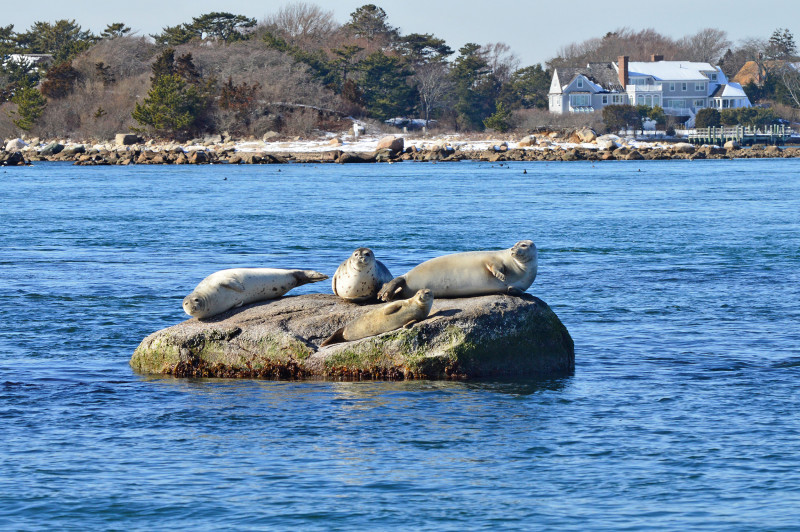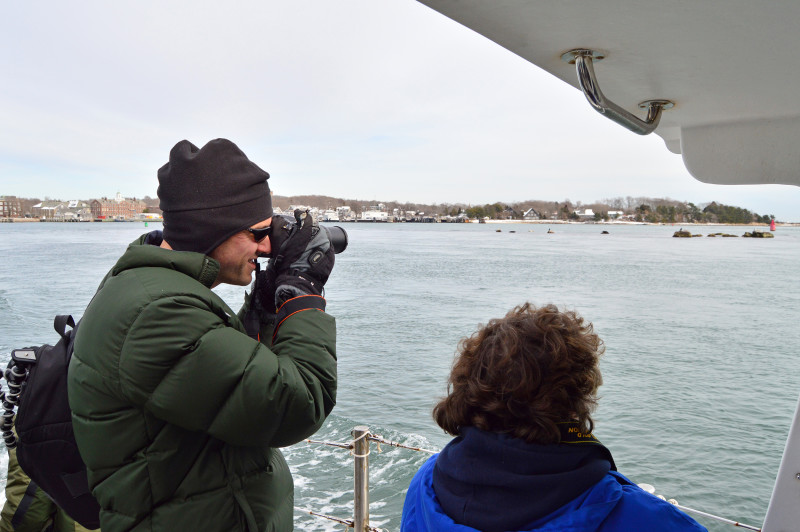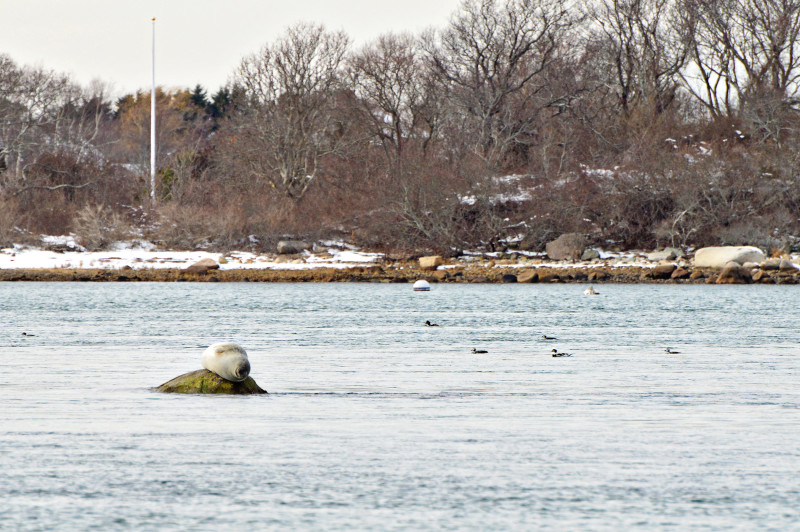5 tips for winter seal watching in Buzzards Bay
During the colder months of the year, Buzzards Bay hosts some beautiful and wild guests from the north – seals. These playful mammals are delightful to see lounging on rocks and beaches along the Bay’s shoreline in winter.
The most common type of seal in Buzzards Bay is the harbor seal, which migrates from Maine and Canada to our warmer coastal waters from October to May. Grey seals also make an appearance in Buzzards Bay from time to time.
It’s exciting to see seals in winter. But there are a few things you should keep in mind so you and these animals stay safe and happy. Read on to learn five important tips for winter seal watching in Buzzards Bay.
1. Learn some facts about seals in Buzzards Bay

Harbor seals are generally gray or brown with dark mottling.
If you see a seal in Buzzards Bay, it’s probably a harbor seal. Their fur ranges in color from light grey to dark brown, speckled with black. Grey seals are less common in Buzzards Bay, but they’re regularly found further out on Cape Cod. You can easily distinguish grey seals from harbor seals because grey seals are significantly larger and have different facial features.
Seal populations are particularly high in Buzzards Bay and Nantucket Sound due to the abundance of food here. Seals are carnivores that eat mostly fish and invertebrates (crabs). They hunt by using their well-developed eyes and ears to locate prey.
One fun fact about seals is their ability to stay underwater for a long time – up to 40 minutes! That’s because of a special adaptation that allows seals to slow their heart rate from 60-70 beats per minute to just 15 beats per minute.
Seals are preyed upon by sharks, orcas, polar bears, and coyotes (which attack pups on land). In the past, hunting by humans greatly reduced seal populations, but today we are no longer considered significant predators. Seals are protected under the Marine Mammal Protection Act of 1972, which makes it illegal to touch, feed, or otherwise disturb them.
2. Look for seals on rocks and beaches
Although seals spend most of their time offshore, they also frequent rocky shores and coastal beaches. In Buzzards Bay, harbor seals can be found from Demarest Lloyd State Park in Dartmouth to Woods Hole on Cape Cod.
Seals prefer rocky, secluded islands and beaches, but will often haul themselves up on piers in harbors and coves such as Apponagansett Bay, New Bedford Harbor, and Nasketucket Bay. Gull Island, located in between Penikese and Nashawena in the Elizabeth Islands chain, is a well-known harbor seal habitat.
Environmental conditions such as tides, wind, temperature, precipitation, and time of day all affect whether seals decide to “haul out,” a term that’s used when seals are on land with their tail and head raised. In general, the best time to watch a seal hauled out of the water is during a mid-day low tide.
3. Keep a safe distance from seals on land and water

Whether you’re on land or water, stay at least 100 feet away from seals and never approach them directly.
Seals are truly wild animals, and we should all appreciate them as such. Getting within 100 feet of a seal will likely scare the animal back into the water. That can be disruptive for seals, since they are on land to rest and store energy before their next hunt for food.
Whether you’re on land or water, try to stay at least 100 feet away from any seals you see. If you need to get past a seal that’s hauled out on a beach or pier, remember to treat the seal with care and respect. Be aware of signs of stress, such as stretching their necks and chests high into the air, starting to move toward or back into the water, looking at you, or increasing their vocalizations.
If you’re on a motor boat and you see a seal nearby, maintain a slow, steady course adjacent to the seal. This indirect path will still allow you to view the seal, but it’s much less threatening than a direct approach. Although kayaks and canoes are smaller, they’re are actually more alarming to seals than motor boats, so it’s best not to approach seals at all when you’re paddling.
4. Know who to call if you see a seal that needs help

Sometimes seals look like they could be hurt or stranded, but it’s likely just part of their normal behavior. If you do see a seal that might be in trouble, call an authorized marine mammal stranding facility.
Many seal behaviors can be mistaken for injuries. For example, seals secrete a watery substance from their eyes that looks like they are crying. This is actually a natural way that seals protect their eyes. Seals can also have bites and scratches on them from other seals. These scrapes may seem like serious injuries, but they typically heal quickly without human involvement.
If you do come across a seal that is severely wounded, in a dangerous area, or entangled in netting, don’t try to touch, feed, or return the animal to the water. Instead, please call an authorized marine mammal stranding facility near you:
- From Plymouth to Rhode Island, including Cape Cod and Buzzards Bay: International Fund for Animal Welfare (IFAW) hotline at (508) 743-9548
- On Martha’s Vineyard and Nantucket: National Oceanographic and Atmospheric Administration Northeast Region (NOAA) hotline at 866-755-NOAA (6622)
- From Plymouth to the New Hampshire border: New England Aquarium hotline at (617) 973-5247
- Outside of Massachusetts: Visit the Marine Mammal Stranding Network website to find an authorized beach response agency or call your local police department.
5. Go on a seal watch with the Coalition
There’s no better way to see seals than to get out on the water, and you can do just that with the Coalition! Each winter, we host seal and seabird watches as part of our Bay Adventures series. Hop on a heated boat and look for seals, seabirds, and other wildlife as we cruise around Woods Hole for an hour.